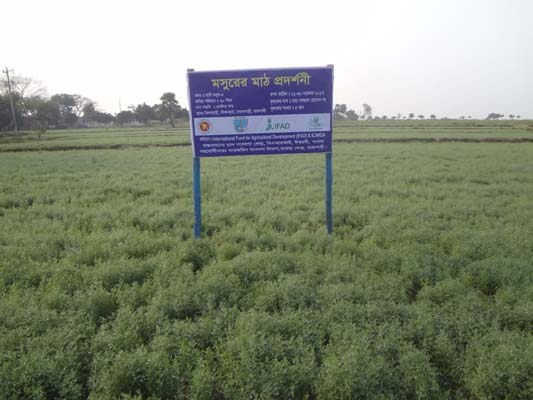RAJSHAHI, April 18, 2021 (BSS) – Farmers have harvested around 71,051 tonnes of lentil from 50,954 hectares of land in all eight districts under Rajshahi division during the recent past harvesting season, officials said.
In addition to meeting up the local nutritional demands, the newly harvested crop has been playing a vital role towards coping with the present adverse situation being caused by the Covid-19 pandemic.
Tozammel Haque, a farmer of Tengramary village under Paba upazila, had cultivated lentils on three-bighas of land this year. “I’ve obtained around five mounds of yield from per bigha of land,” Haque said while talking to BSS here today.
“A farmer can get four to five maunds of lentil from per bigha of land on an average. One maund of lentil is now being sold at Taka 4,200 to 4,300 in local markets,” he said, adding that the growers here are showing more interest in lentil cultivation as it does not take much irrigation cost.
Besides, the farmers of the region got abundant production during the last couple of years.
“We’re cultivating lentils to avoid hassle in getting irrigation water for paddy,” said Abir Hossain, another farmer of Harishankar Pur village under Godagari upazila. He mentioned that the acreage of lentil is increasing day by day here.
Hossain said he has cultivated lentils on four bighas of land this year without spending extra money for irrigation and he is happy with his attained yield of the cash crop.
Sirajul Islam, additional director of the Department of Agriculture Extension (DAE), said all possible measures were adopted to boost the lentil production.
Newly developed high yielding varieties were provided to the farmers to make them happy with enhanced yield.
Some 21,200 farmers were given seed and fertilizer support for lentil farming to recoup their losses caused by the devastating flood in the division.
Besides, all the government and non-government entities concerned are motivating the farmers for farming various less-water consuming crops including lentils in the Barind area to lessen the gradually mounting pressure on underground water, he said.
He, however, said pulse farming is increasing gradually in the region including its vast Barind tract as its cultivation and irrigation cost is less compared to many other crops especially paddy.
Dr Shakhawat Hossain, senior scientific officer of On Farm Research Division under Bangladesh Agriculture Research, said huge lentil output is possible in the Barind region if it is cultivated on around 80,000 hectares of land, which usually remains fallow for more than three months after the harvest of transplanted Aman paddy every year.
He said more than 1,500 volunteers are encouraging and inspiring farmers to cultivate the less water consuming crops through water resource management on behalf of the ‘Integrated Water Resource Management (IWRM)’ Project.
DASCOH Foundation has been implementing the IWRM project in 1,280 drought-hit villages under 39 Union Parishad (UP) and three municipalities in eight upazilas of Rajshahi, Naogaon and Chapainawabganj districts with financial support of Swiss Agency for Development and Cooperation since 2015.
Farmers have started showing interest in lentil cultivation as they reaped a lucrative market price of the crop in the last couple of years, said IWRM Project Coordinator Jahangir Alam Khan.
Professor of the Department of Geology and Mining in Rajshahi University (RU) Chowdhury Sarwar Jahan said, “The farmers in high Barind areas have to spend much for irrigation in paddy farming, but lentil cultivation needs less irrigation. So, farmers are interested in cultivating lentil.”
More expansion and promotion of various water-saving crops in the water-stressed areas can be the best ways of lessening the gradually mounting pressure on groundwater resources, he mentioned.
He said the policy planners and the research organisations working in this field should take the responsibility of motivating the growers for the best uses of the existing potentialities in the dried area.



